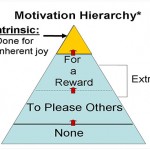Clothes and performance: the secrets of workplace attire

Barack Obama and Mark Zuckerberg have one quite bizarre thing in common: they each wear similar clothes every day. Steve Jobs and Albert Einstein used to have the same habit.
What is more, even some fashion gurus like Vogue’s Grace Coddington and Chanel’s Karl Lagerfeld prefer to dress the same. And all this for very valid reasons which are backed by science, not pulled out of a hat.
So let’s roll up our sleeves and find out what drives this type of behavior in famous professionals and how we can benefit from it as well.
More willpower for decision making
At the beginning of this year, Mark Zuckerberg published a quite humorous post on his Facebook page:

However, the logic behind this monotonous sight is no laughing matter at all. In fact, it is the same logic standing behind the actions of Barack Obama and even Einstein. Psychologists call the phenomenon decision fatigue and thereby refer to the mental burden of taking decisions.
Let’s step into the shoes of Obama and Zuckerberg for a moment. They are both held accountable by millions of people. The professional decisions they make have a strong impact on many societal sectors. All decisions imply making choices.
Each time the individual makes one, regardless if it’s related to stock investment or deciding whether to eat a delicious cake or better hold back, a specific mental process is activated.
This cognitive process is based on weighing the pros and cons of each alternative – reward versus risk. This mental analysis and the impulse to control it drain willpower, which affects the individual’s ability of making further judgements.
Zuckerberg proved to be well aware of this fact, stating:
“I really want to clear my life to make it so that I have to make as few decisions as possible about anything except how to best serve this community”.
The same goes for Obama, who said that:
“You’ll see I wear only gray or blue suits. I’m trying to pare down decisions. I don’t want to make decisions about what I’m eating or wearing. Because I have too many other decisions to make.”

Clothed cognition – The influence clothes have on the wearer
Mass media is splendidly clothed with advice on the most suitable workplace attire. From fashion magazines to psychological journals, a great number of publications indicate the best way professionals should dress in order to achieve maximum success. Most of these best practices rely on the effect our clothes have on others by creating favorable impressions.
However, a research study conducted by the Northwestern University takes on a revolutionary perspective: the impact clothes have on the wearer. Because, as the study proves, they do influence the way people wearing them think, feel and act.
As a first step, the paper cites several studies as interesting examples on how others are affected by our attire: formally dressed employees are generally perceived as being more competent and intelligent by clients; women wearing formal clothing are more likely to succeed in hiring interviews, while on the other hand, if dressed provocatively, they give the impression of being less qualified and capable.
Afterwards, the scientific work offers examples on how individuals themselves are influenced by what they wear: nurse uniforms make people act more emphatically, while large hoods increase the likelihood of them administering electric shocks; women wearing a bikini in classrooms tend to obtain lower scores in math tests than they would if dressed properly.
This last effect, the influence wearing a lab coat has on test subjects, is the main focus of the study.
First things first, lab coats are the classical attire of scientists, thus symbolizing precise knowledge, increased attentiveness and a greater focusing ability.
In one of the experiments conducted as part of this research endeavor, participants were asked to wear a lab coat and solve exercises requiring focus and attention. One group was told the coat was a doctor’s coat, while to the others it was described as a painter’s. Just like the scientists predicted, wearing a coat which was allegedly destined for doctors increased the group’s performance in attention related tasks.
This and other similar tests drew the conclusion that clothed cognition – the influence cloths have on the wearer’s psychological processes – is a fact and occurs if two factors are present:
- The clothes have a symbolic, cultural or traditional meaning;
- They have to be physically worn by the person which is supposed to be influenced, not simply displayed in their presence.
We have to take our hat off in front of these findings, which conclude that clothes can have strong psychological and behavioral effects on their wearers.
Clothes can cause people to embody their symbolic meaning, by triggering certain psychological processes associated with them. In other words, clothes do make you become what you wear.

How can this knowledge be the ace up our sleeve and increase our performance?
It’s important to note that we don’t have to wear the same outfit every day, like Obama or Zuckerberg, in order to save up on our mental energy. This could indeed be an option for professionals who are tasked with numerous responsibilities, however the principle can be applied in many ways.
For instance, your wardrobe can be simplified by limiting the color palette to fewer complementary shades which are easy to combine. This doesn’t mean the garments have to be plain – they can be carefully and meticulously chosen according to the preferences and statement the wearer wants to make; furthermore, you can always keep a certain dress code and unwaveringly stick to it if you feel that it fits you.
Besides easing the task of deciding what to wear each day, these tactics also provide an exclusive signature style, which is an important component in personal branding.
Furthermore, you can complement this strategy by trying your best to adopt healthy habits in all personal life areas. As a result, routines are built and unnecessary daily decisional struggles are avoided. Certain parts of your day could be customized to happen based on a recurring schedule, without risking the installment of boredom.
Take morning routines for example – waking up, showering, driving to work. These are all activities which can be repeated over and over without requiring too much mental effort. The same goes for daily meals, which can be planned or even cooked in advance in order to avoid deciding on the best dinner option after a hard day at work.
This list of routines can go on and be adapted in accordance to each individual’s preferences and priorities.
As far as the concept of clothed cognition is concerned – the results of the study suggest that the clothes we wear influence the way we think, feel and act. By extrapolating the results of the lab coat experiment, it can be stated that wearing attire typical for a certain activity can lead to greater performance in that specific field.

Now, on the one hand, wearing a neat business suit gives the wearer not only confidence, but also the abilities he/she as well as society associate with the said suit – professionalism, decisiveness, control, dignity and so forth.
On the other hand, putting on sports clothing may increase the wearer’s stamina and energy. So it all boils down to personal preference and dressing for the occasion, whether it’s going to work or for a jog. In addition to this, the authors of the study even speculate that wearing the robe of a judge might increase ethical behavior or that a firefighter uniform might increase courage levels.
These results seem to be quite conclusive and the best way we can exploit them is to dress not only according to the influence we want to exert on others, but in accordance to the ideal behavior we would like to have in the situation we dress up for. In other words, we should dress for the occasion in order to optimize our performance, as often as possible.
In this regard, clothed cognition can also be a wolf in sheep’s clothing. For instance, if our employer allows it, we might prefer wearing casual clothes at work. While this might make us feel more at home, comfortable and relaxed, it also might weaken our focusing ability.
Moreover, keeping the same dressing style might blur the line between professional and personal life, making it hard to switch off work mode. For this reason, it is important to pay attention to this aspect and try to keep small but distinctive differences between office and leisure attire.
In conclusion, these are performance’s new clothes: avoiding decision fatigue and paying attention to the clothed cognition phenomenon. This does not have to happen at the drop of a hat. Rather, we should incorporate the two principles into our lives gradually and make our habits fit them like a glove over time.
Image sources:

Tags: Northwestern University, Personal performance, Research






Frankie Riddle
| #
I like the efforts you have put in this, regards for all the great content.
Reply